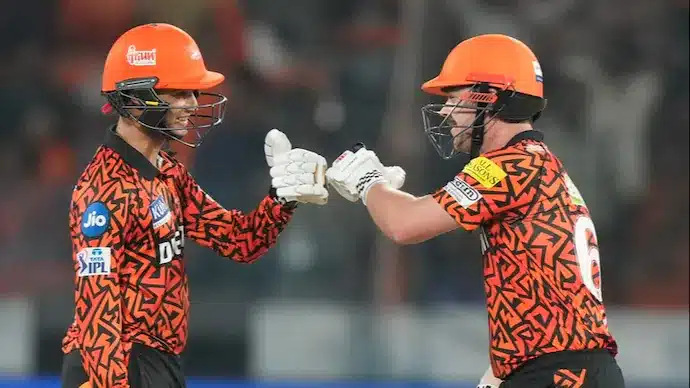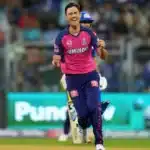Jarrod Kimber, Saurabh Somani
Sunrisers Hyderabad capped an unforgettable IPL 2024 campaign with a forgettable final. But while they lost decisively to an incredibly complete Kolkata Knight Riders, they were undoubtedly the second-best team in the competition, and had the performances to match.
Why they reached the final:
SRH pushed the bounds of what was thought possible in T20 cricket with their batting in this tournament. They went harder in the powerplay than any team has, and they didn’t panic when the inevitable failures came along the way. They trusted their gameplan and the ability of their personnel to execute it, and overall, it didn’t let them down. Travis Head and Abhishek Sharma emerged as the power couple of the tournament, with the emphasis on ‘power’. SRH broke the record for the highest score in the IPL, then broke their own mark. They hit 125 runs in the powerplay. Ironically they would score less than that in their full innings in the final, but what allowed them to get to the final in the first place was playing in that manner.
What made the approach work was the terrific form of Travishek, and their single-minded clarity in what they wanted to do. They weren’t fussed with concepts like ‘one set batter should bat through the innings’, or ‘if one man is going great guns, the other should just rotate strike’. They batted with the intent of going for an aggressive shot on the last ball even if they had five boundaries in an over. SRH overwhelmed teams with their batting might, and turned their home ground into a particular fortress. They did that by making flat pitches, knowing that their openers, with Heinrich Klaasen in the middle supported by the rising Nitish Reddy, would most likely be enough to bat any team out of the game. SRH’s bowling flew under the radar somewhat, but came most tellingly to the fore in Qualifier 2, when the batters had put up a sub-par total. Bhuvneshwar Kumar had an indifferent start, but bowled with nous in the second half. T Natarajan was reliable throughout the competition, as was Pat Cummins, the captain. While they weren’t a potent spin-force, it was Shahbaz Ahmed and Abhishek’s left-arm spin that won them Qualifier 2.
Who have been the stars:
Travishek, of course. Their failures in the last two games don’t negate in any way what they achieved during the season. Head had 567 runs in 15 games, despite three ducks in his last four matches. He averaged 40.50 at a stunning strike rate of 192. Abhishek made 484 runs in 16 matches, and while his average was lower, at 32.30, his strike rate was a remarkable 204, surpassing even Head. The glut of runs the openers made stole the headlines, but Klaasen down the order was equally effective, with 479 runs at an average of 40 while striking at 171.
Various bowlers chipped in for SRH, making the whole greater than the sum of their parts. But foremost amongst them was Natarajan. Tasked with bowling the tough overs – powerplay and death, he found his old, yorker-nailing form and kept it through the IPL. He ended up as the team’s leading wicket-taker too, with 19 scalps at 24.5. His economy was 9.05, but in a batting blitz season, that was better than par for the phases he bowled in.

Who over-performed:
It feels weird to say this about Cummins, because his general playing level is already excellent or better. However, Cummins the bowler hadn’t been exceptional in the IPL till now. This year, he corrected that. He was in the avatar that is familiar when you think of Cummins: among the best in the business. He controlled the middle-overs with his hard lengths, off-pace deliveries and cutters into the batsmen. He bowled in the powerplay and at the death too when needed. His price tag of INR 20.50 crore was looked at with a few raised eyebrows, but SRH trusted the inherent quality in Cummins the bowler, and the obvious leadership aspect, and knew what they were doing. Cummins the bowler justified that price tag, as did Cummins the captain. He allowed the openers to go all guns blazing with freedom, with the assurance that failures wouldn’t lead to drastic repercussions. He seemed to imbue the whole squad with a confidence and assurance that had been missing in previous seasons, under previous leaders.
Before IPL 2024, Nitish Reddy’s T20 stats read: 92 runs in four innings. His average was only 23 and strike rate was below 96. SRH wisely did not read too much into such a small sample for such a young player. In return, he made 303 runs at 33.67, striking at 143. He was also called on to bowl in nine innings, delivering 18.1 overs. An average of two overs per innings suggests Nitish was more part-timer than genuine bowling option, but he showed sparks during his brief forays to suggest a much more promising future. He’s a seam-bowling allrounder with massive upside potential at only 21 years old. It’s like finding the pot of gold at the end of the rainbow for Indian cricket.
What hasn’t worked:
Their two major issues were the batting depth and the strength of their spin-bowling attack. While Head and Abhishek’s form covered a lot of the former, the gaps were exposed in the games they lost. Aiden Markram started brightly, but his lack of rhythm and game-time clearly showed in the second half of the tournament. The main responsibility for helming the middle order was on the overseas pros, but that didn’t quite happen. And for all the faith they kept in Abdul Samad, he had a forgettable tournament. He bats at a tough number, but due to a few quick wickets, he had the time and space this season to get into an innings, but he did not play too many innings of note.
Their spin attack had Mayank Markande and Shahbaz Ahmed. Markande got fewer games than he might have because SRH’s penchant to bat first, and a few collapses there, meant they had to sub in a batter fairly often. Vijayakanth Viyaskanth was tried for a few games, but his leggies were also not too penetrative. They were unfortunate that Umran Malik couldn’t get a game. He was due to come in as Impact Sub in several matches, but each time SRH batted first and had a collapse, which meant an extra batter was subbed in instead. Umran’s X-factor pace could have given their bowling a keener edge, but their options to play him were constrained.
Why they lost the final:
You could say the lack of batting depth hurt them badly, and to an extent that’s true too. However, they were up against the best bowling side in the competition, which was even more strengthened by Mitchell Starc finding searing hot form. When Starc is landing his yorkers and got the zip in his bowling, he’s a candidate for a World XI. Add him to an already good bowling attack, and it’s lethal. So even greater batting depth might not have given SRH enough runs. The reality is, they were up against a supremely great T20 side which somehow pulled off having immense batting depth with attacking intent, alongside a great attack. To combat that, SRH needed one of their batting guns to have one of their box-office days, but none of Head, Abhishek or Klaasen were allowed to get away, which shut SRH out of the game pretty early.




